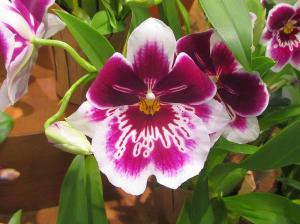Link to Printable Culture Sheet on Miltonia
Miltonia including Miltoniopsis
mil-TOH-nee-ah (mil-toh-nee-OP-siss)
These  striking orchids, which are also known as pansy orchids, owing to their similarity to garden pansies, are enjoying increasing popularity. Miltoniopsis are cool-growing orchids that originate in the higher elevations of the Andes in Colombia, Panama and Ecuador. The warmer-growing species, properly miltonias, originate from the Minas Gerais area of Brazil and more closely resemble large-flowered oncidiums. Their flowers can be brilliantly patterned.
striking orchids, which are also known as pansy orchids, owing to their similarity to garden pansies, are enjoying increasing popularity. Miltoniopsis are cool-growing orchids that originate in the higher elevations of the Andes in Colombia, Panama and Ecuador. The warmer-growing species, properly miltonias, originate from the Minas Gerais area of Brazil and more closely resemble large-flowered oncidiums. Their flowers can be brilliantly patterned.
Light should be relatively shaded. Direct sunlight burns the thin leaves within a short period of time. However, the warmer growing types prefer more light than their cooler-growing relatives. The cool-growing species need approximately 1,200 foot-candles, while the warmer-growing species require closer to 2,000 foot-candles.
Temperature is critical for the cool-growing plants. Unless temperatures are kept under 80 F, they may not flower. The minimum temperature is 50 to 55 F. Thus, these are really better thought of as intermediate growers because they need intermediate temperatures throughout the year – not too hot, not too cold. The warmer growers will take temperatures over 90 F as long as humidity levels of 70 to 75 percent, or higher, are maintained. The minimum temperature is 60 F.
Water must be plentiful and the medium must drain perfectly. In their native habitat, the plants are drenched almost daily and, because of this, they are intolerant of salt buildup, so leaching every fourth or fifth watering is important when growing in pots. When they are not getting enough water or humidity, the leaves have a tendency to grow with accordion-like pleats. The warmer-growing miltonias should be grown like cattleyas; allow them to approach dryness between waterings. They also tend to be slightly more tolerant of salt buildup than their Colombian cousins so they can dry more between waterings.
Humidity must be at least 70 percent because of the plants’ need for abundant water. Less humidity will stress the plants and can lead to susceptibility to disease, though too much humidity is worse than too little.
Fertilize at the same level as other orchids: half-strength, balanced fertilizer every two weeks. This can be reduced by half during overcast weather or in winter. A 10-30-20 blossom-booster formulation is beneficial in early spring when plants approach their flowering period.
Potting should be done after flowering when the new growth is starting. Miltoniopsis should be repotted every year as they are intolerant of stale conditions. The cool growers (miltoniopsis) do well in small pots. The warmer growers (miltonias) tend to have a relatively elongated creeping habit and, therefore, do better mounted. Any potting mix suitable for fine roots such as 70 percent seedling bark with charcoal and perlite or a mix of 70 percent tree fern and 30 percent chopped sphagnum is adequate. Mounts may be cork, tree fern or other hard wood. They should be longer than wide. For some reason, shallow pans work better than deep pots.

You must be logged in to post a comment.